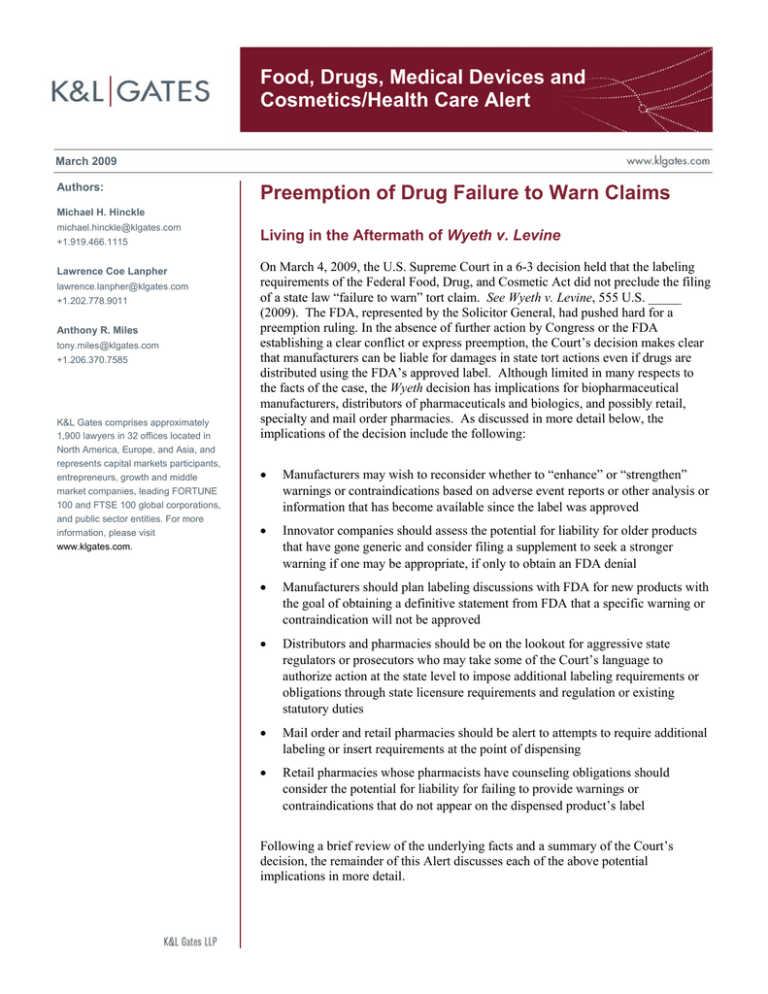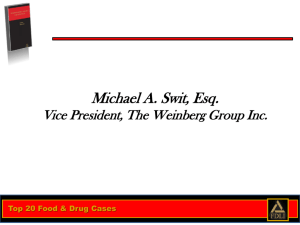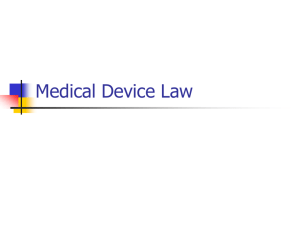Food, Drugs, Medical Devices and Cosmetics/Health Care Alert
advertisement

Food, Drugs, Medical Devices and Cosmetics/Health Care Alert March 2009 Authors: Preemption of Drug Failure to Warn Claims Michael H. Hinckle michael.hinckle@klgates.com +1.919.466.1115 Lawrence Coe Lanpher lawrence.lanpher@klgates.com +1.202.778.9011 Anthony R. Miles tony.miles@klgates.com +1.206.370.7585 K&L Gates comprises approximately 1,900 lawyers in 32 offices located in North America, Europe, and Asia, and represents capital markets participants, entrepreneurs, growth and middle market companies, leading FORTUNE 100 and FTSE 100 global corporations, and public sector entities. For more information, please visit www.klgates.com. Living in the Aftermath of Wyeth v. Levine On March 4, 2009, the U.S. Supreme Court in a 6-3 decision held that the labeling requirements of the Federal Food, Drug, and Cosmetic Act did not preclude the filing of a state law “failure to warn” tort claim. See Wyeth v. Levine, 555 U.S. _____ (2009). The FDA, represented by the Solicitor General, had pushed hard for a preemption ruling. In the absence of further action by Congress or the FDA establishing a clear conflict or express preemption, the Court’s decision makes clear that manufacturers can be liable for damages in state tort actions even if drugs are distributed using the FDA’s approved label. Although limited in many respects to the facts of the case, the Wyeth decision has implications for biopharmaceutical manufacturers, distributors of pharmaceuticals and biologics, and possibly retail, specialty and mail order pharmacies. As discussed in more detail below, the implications of the decision include the following: • Manufacturers may wish to reconsider whether to “enhance” or “strengthen” warnings or contraindications based on adverse event reports or other analysis or information that has become available since the label was approved • Innovator companies should assess the potential for liability for older products that have gone generic and consider filing a supplement to seek a stronger warning if one may be appropriate, if only to obtain an FDA denial • Manufacturers should plan labeling discussions with FDA for new products with the goal of obtaining a definitive statement from FDA that a specific warning or contraindication will not be approved • Distributors and pharmacies should be on the lookout for aggressive state regulators or prosecutors who may take some of the Court’s language to authorize action at the state level to impose additional labeling requirements or obligations through state licensure requirements and regulation or existing statutory duties • Mail order and retail pharmacies should be alert to attempts to require additional labeling or insert requirements at the point of dispensing • Retail pharmacies whose pharmacists have counseling obligations should consider the potential for liability for failing to provide warnings or contraindications that do not appear on the dispensed product’s label Following a brief review of the underlying facts and a summary of the Court’s decision, the remainder of this Alert discusses each of the above potential implications in more detail. Food, Drugs, Medical Devices, Cosmetics/Health Care Alert Wyeth: Facts of the Case The case stemmed from a tragic set of facts that left Diana Levine an amputee. Levine suffered from migraine headaches and was treated with intravenous Demerol (meperidine HCl) for pain and Phenergan (promethazine HCl) for nausea. Although the Phenergan labeling included numerous and specific warnings on the risks associated with injecting the drug directly into a vein (“IV-push”), Levine’s physician opted to administer the drug via an IV-push instead of the safer, but slower, IV-drip administration. The drug was improperly administered, entered an artery and ultimately resulted in the need to amputate Levine’s arm. After settling with the physician and the hospital for an undisclosed amount, Levine filed suit in Vermont state court against Phenergan’s manufacturer, Wyeth, alleging that the drug’s labeling did not contain sufficient warnings about the dangers associated with IV-push. Wyeth countered by arguing that it could not provide a stronger warning, since federal law prescribed what it could and could not put in its labeling. The trial court rejected Wyeth’s argument, and the jury awarded Levine approximately $7 million in damages. Wyeth unsuccessfully pressed its preemption argument before the Vermont appellate courts before obtaining a writ of certiorari from the U.S. Supreme Court on the question of whether the FDA’s drug labeling judgments “preempt state-law product liability claims premised on the theory that different labeling judgments were necessary to make drugs reasonably safe for use.” Arguments and Decision in U.S. Supreme Court At the Supreme Court, Wyeth argued for preemption on two grounds: (1) that it was impossible to comply with both the federal and state labeling requirements; and (2) that the state requirement frustrated the objectives and purposes of the federal drug regulatory scheme. The Court denied both arguments and affirmed the Vermont Supreme Court’s judgment. With respect to the impossibility argument, the Court stated that “[i]mpossibility preemption is a very demanding defense.” The Court ruled that even under the FDA’s recently amended “changes being effected” rule, Wyeth had the ability to revise drug warning labels without obtaining prior FDA approval and that there were sufficient data in the record to support a finding that Wyeth should have changed the warning in light of at least 20 incidents requiring amputation that occurred prior to the Levine event. Importantly, the Court emphasized that the manufacturer, not the FDA, bears responsibility at all times for the adequacy of the content of the drug label. With respect to the argument that dual federal and state regulation of drug labels frustrates the purposes of the federal drug regulatory scheme, the Court had little trouble rejecting the claim. In large part, the Court relied on the long history of state law failure to warn claims and the repeated failure of Congress to enact an express preemption provision. The Court also was critical of the FDA for having “reverse[d] . . . [its] own longstanding position without providing a reasoned explanation, including any discussion of how state law has interfered with the FDA’s regulation of drug labeling during decades of coexistence.” The Court also noted that the FDA had pushed for broad drug preemption via an FDA rulemaking that lacked any notice to states and other interested parties that the regulations in question would have broad preemption language in their preamble. The Court termed this a “procedural failure” and ruled that neither the FDA’s preamble nor the Solicitor General’s brief was entitled to deference. Implications for Manufacturers At first glance, the Wyeth decision appears to foreclose a preemption defense for pharmaceutical companies facing “failure to warn” state tort claims. However, the Court’s opinion was actually somewhat narrowly tailored to the facts surrounding FDA’s review of the Phenergan labeling. Justice Stevens, when addressing Wyeth’s “impossibility” argument, concluded that “absent clear evidence that FDA would not have approved a change to Phenergan’s label, we will not conclude that it was impossible for Wyeth to comply with both federal and state requirements.” Therefore, “clear March 2009 2 Food, Drugs, Medical Devices, Cosmetics/Health Care Alert evidence” that FDA prohibited or would have prohibited an application holder from strengthening a warning or adding a contraindication would seem to support an “impossibility” preemption position. Obtaining such evidence from FDA may not be easy. However, a company seeking to preserve its preemption defense may want to conduct its labeling discussions with FDA with the goal of obtaining a definitive statement from FDA that a specific warning or contraindication will not be approved. We offer a caution, however, that it will likely take some time for the courts to decide whether there is sufficiently “clear evidence” that the FDA has prohibited or would have prohibited a label change, such that impossibility preemption can be proven. The Third Circuit in April 2008 in a 2-1 decision found preemption in a failure to warn case based upon a finding that the FDA on repeated occasions had declined to increase warnings about the possible danger that an anti-depression drug could increase the risk of suicide. Colacicco v. Apotex, Inc., 521 F.3d 253 (3d Cir. 2008). On March 9, 2009, five days after issuance of the Wyeth decision, the Supreme Court granted certiorari in Colacicco, vacated the decision, and remanded for further consideration in light of the Wyeth decision. Colacicco v. Apotex, Inc., 555 U.S. ___, 2009 U.S. LEXIS 1818 (March 9, 2009). Likewise, pharmaceutical companies in the wake of the Wyeth decision may want to reconsider what warnings or contraindications should be included in their drug product labeling. Innovator companies should be mindful of potential liability for older products that have gone generic. A California state appellate court recently found an innovator company liable in a “failure to warn” case where the plaintiff had been dispensed a generic version of the innovator’s drug. See Conte v. Wyeth, 168 Cal. App. 4th 89 (Nov. 7, 2008), review denied, 2009 Cal LEXIS 233 (Cal. Jan. 21, 2009). Generic manufacturers, however, should be wary of relying too much on the Conte decision in light of the fact that it conflicts with many other courts that have held that innovators owe no duty to patients who take generic versions of their drugs. See Foster v. American Home Products, Corp., 29 F.3d 165 (4th Cir. 1994). Abbreviated New Drug Application (“ANDA”) holders are prohibited from having warnings in their labeling that differ from the reference listed drug (i.e., equivalent innovator drug) labeling. See 21 C.F.R. § 314.150(b)(10). Nevertheless, in light of the Wyeth decision and the uncertainty surrounding an innovator company’s duty to patients taking generics, ANDA holders may wish to consider filing a supplement to add a stronger warning if the ANDA holder believes such a warning is warranted. FDA will almost certainly refuse to approve such a supplement, but the written refusal from the Agency may provide support for a preemption position concerning the specific warning at issue. Although it may be tempting to do so, adding every conceivable risk to drug product labeling may not be an acceptable answer. FDA has frequently warned industry of the risk of “overwarning” and has even suggested that a drug product could be “misbranded” as a result of an overly strong warning. The Agency, however, has never taken an enforcement action against labeling that was overly cautious with warnings or contraindications. Implications for Distributors and Pharmacies Although Wyeth should be limited to state tort actions involving product liability claims, the Court’s opinion also may encourage aggressive regulators to impose additional labeling requirements within their jurisdiction. In contesting the FDA’s position on implied preemption in the litigation, the Court’s opinion highlights FDA’s prior support for additional state labeling requirements in response to comments in connection with its 1998 final rule requiring Medication Guides. Specifically, FDA stated that “states may authorize additional labeling, but they cannot reduce, alter or eliminate FDA-required labeling.” 63 Fed. Reg. 66378, 66384 (Dec. 1, 1998). Relying on existing counseling requirements and civil rights statutes, the New York State Attorney General recently began a campaign to require pharmacies dispensing drugs within the state to make available drug labels in the six foreign languages spoken by more than 1% of state residents. See http://www.oag.state.ny.us/media_center/2008/nov/ nov13a_08.html. Wyeth may encourage regulators to go beyond mere access issues to address perceived deficiencies in the substance of Medication Guides. Such action threatens to create March 2009 3 Food, Drugs, Medical Devices, Cosmetics/Health Care Alert a patchwork of labeling requirements that could bedevil mail-order pharmacies and others with multi-state operations. In addition, Wyeth also suggests that specialty pharmacies that provide or contract for provision of injection or infusion services in multiple states may not rely on the warnings and contraindications stated on the FDA-approved label to meet the standard of care, and may need to pay attention to additional state labeling requirements in connection with the administration of drugs to patients in different states. State regulators also may attempt to implement safety-related labeling requirements by imposing sanctions on distributors who deliver drugs within the state that do not include state-mandated requirements. In such an event, distributors and manufacturers may be better served to seek a preemptive regulation jointly from FDA rather than by trying to allocate their respective potential liabilities through contract negotiations. different from what existed 10 years ago. Over the past eight years, FDA has attempted to expand preemption beyond its historically accepted boundaries. While there are good policy reasons supporting the argument for increased preemption in the area of drug labeling, the end result is that the Supreme Court has not agreed and the industry is back to where it was before the Bush administration. More favorably, the medical device industry continues to benefit from the express preemption clause included in the Medical Device Amendments of 1976. In 2008, the Supreme Court upheld preemption for medical devices approved through the premarket approval process. See Riegel v. Medtronic, Inc., 552 U.S. ____ (2008). It should be noted, however, that on March 11, 2009, Representatives Pallone and Waxman introduced legislation, The Medical Devices Safety Act of 2009, which would have the effect of reversing the Riegel decision. It is beyond the scope of this Alert to seek to assess the likelihood that this legislation will be enacted. Conclusion In sum, the current preemption situation with regard to “failure to warn” claims is not significantly K&L Gates comprises multiple affiliated partnerships: a limited liability partnership with the full name K&L Gates LLP qualified in Delaware and maintaining offices throughout the U.S., in Berlin and Frankfurt, Germany, in Beijing (K&L Gates LLP Beijing Representative Office), in Singapore (K&L Gates LLP Singapore Representative Office), and in Shanghai (K&L Gates LLP Shanghai Representative Office); a limited liability partnership (also named K&L Gates LLP) incorporated in England and maintaining our London and Paris offices; a Taiwan general partnership (K&L Gates) which practices from our Taipei office; and a Hong Kong general partnership (K&L Gates, Solicitors) which practices from our Hong Kong office. K&L Gates maintains appropriate registrations in the jurisdictions in which its offices are located. A list of the partners in each entity is available for inspection at any K&L Gates office. This publication is for informational purposes and does not contain or convey legal advice. The information herein should not be used or relied upon in regard to any particular facts or circumstances without first consulting a lawyer. ©2009 K&L Gates LLP. All Rights Reserved. March 2009 4






